|
|

|
|
Author
|
Topic: Space Cover 808: Shuttle PAM contractors
|
randyc
Member Posts: 933
From: Denver, CO USA
Registered: May 2003
|
 posted 06-01-2025 11:21 AM
posted 06-01-2025 11:21 AM
   
Space Cover of the Week, Week 808 (June 1, 2025)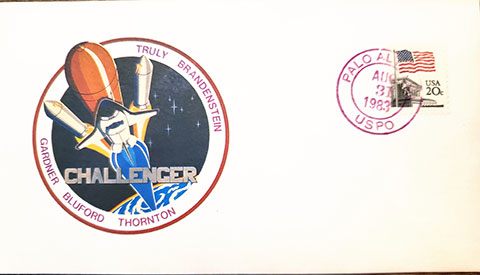 Space Cover 808: Shuttle PAM Missions ContractorsThis is my first posting as a new member of the Space Cover of the Week group, so before I discuss the covers that are shown in this message I thought I would start by introducing myself. My name is Randy Constantin and I've been a member of the collectSPACE community since 2003. I'm a retired Mechanical Engineer with more than 42 years in the Aerospace industry. I've been interested in the space program since I can recall when I first painted a picture of a Lunar Module on the Moon while in Elementary School. After watching the first B&W TV broadcasts from Lunar Orbit on Christmas Eve, 1968 during the Apollo 8 mission, I decided that I wanted to be an engineer and work in the Aerospace industry After graduating from college with a degree in Mechanical Engineering I accepted a position with McDonnell Douglas Astronautics Company (MDAC) in Huntington Beach, CA. At MDAC I worked at both Huntington Beach and Cape Canaveral AFS (Launch Complex 17) on the Delta Program, and on the Payload Assist Module (PAM), Italian Research Interim Stage (IRIS) and Space Station Programs. I designed the Uprated PAM-D Spacecraft Separation System that deployed the INSAT-1B and ARABSAT-1B Spacecraft on STS-8 and STS-51G and the Motor Attach Fitting Separation System for the IRIS that deployed the LAGEOS-II Spacecraft on STS-52. In 1988 I joined the Space Station Program and was the Chief Engineer of the Space Station Airlock and Mission Build 7 Manager from 1988-1992 and Chief Engineer of Segment S2 of the Integrated Truss Assembly and Mission Build 2 Manager from 1992-1993. After four years at Douglas Aircraft Company in Long Beach, CA as a Program Engineer I returned to Huntington Beach and was an Engineering Integration Manager at Boeing and United Launch Alliance (ULA) for three missions using the Delta IV and Atlas V Launch Vehicles. I completed my career working for Northrop-Grumman as a Mission Manager on the OmegA Launch Vehicle Program and as a Program Manager at a small Aerospace start-up company. I started collecting space covers when I was 12 years old in 1968 when I bought covers at the stamp department at a Gimbels department store. I collected covers from most of the cachet makers at the time for manned and unmanned missions, but now my focus is on pre-Shuttle manned missions and completing specific areas of my collection such as crew-signed covers, crew-signed Official NASA cachet covers and crew-signed Prime Recovery Ship covers. For my first SCOTW topic I've chosen covers cancelled for Shuttle missions that flew the McDonnell Douglas Payload Assist Module (PAM). The Payload Assist Module used on Shuttle missions was developed to raise the orbit of Spacecraft from the lower orbit of the Shuttle to a higher transfer orbit where the Spacecraft's on-board propulsion system, usually a solid propellant Apogee Kick Motor (AKM), would be used to place the Spacecraft in it's operational orbit. The PAM System consisted of a Cradle that provided structural support and was secured to the Cargo Bay, a Spintable, a clamshell Sunshield that provided thermal protection to the Spacecraft until deployment, a Solid Rocket Motor (SRM), a Payload Attach Fitting (PAF) that secured the Spacecraft to the SRM, and deployment mechanisms (Spring Actuations and Clampband Separation Systems). When it was time to deploy the Spacecraft the Sunshade would open, the spintable was activated, and when reaching the appropriate spinrate the Spacecraft/PAM was separated from the Spintable by sending electrical signals to two explosive bolt cutters that cut through two pre-loaded bolts that held two segments of the Spintable Separation System clampband together. When the bolts were cut the clampband would open and be held in the open position by a set of retainers. The Spacecraft/PAM would then be pushed out of the Cargo Bay by four Spring Actuators. When the Spacecraft/PAM was in the correct orbital position, around 45 minutes after deployment from the Shuttle, the SRM was fired, placing the Spacecraft into a higher transfer orbit. After SRM burnout the Spacecraft Separation System, which was similar to the Spintable Separation System, was activated and the Spacecraft was pushed away from the PAM. Later the AKM on the Spacecraft would fire to place the Spacecraft into it's operational orbit. There were three Shuttle compatible configurations of the PAM: PAM-D which was used to deploy Delta-class payloads weighing up to 2750 lbs., PAM-DII which used a larger solid rocket motor for heavier payloads up to 4150 lbs. and PAM-S which was used in combination with a Boeing Inertial Upper Stage (IUS) and did not use a Cradle, Sunshield or Spintable. Another configuration for Atlas-class payloads weighing up to 4400 lbs., called PAM-A, was in development but the project was cancelled after the Challenger accident and no PAM-As were flown. The first use of the PAM-D on the Space Shuttle was on STS-5. That mission used two PAM-Ds that deployed the Anik C-3 and SBS-C Spacecraft. PAM-Ds and PAM-DIIs were flown on 11 Shuttle missions and were used to deploy 20 Spacecraft. The PAM-S configuration was flown once to deploy one Spacecraft. The last flight of a PAM used the PAM-DII configuration on STS-61C that was launched on January 12, 1986 and deployed the Satcom KU-1 Spacecraft. After the Challenger accident on January, 28, 1986 no additional PAMs were flown on the Shuttle with the exception of the PAM-S/IUS during the STS-41 mission in October 1990. 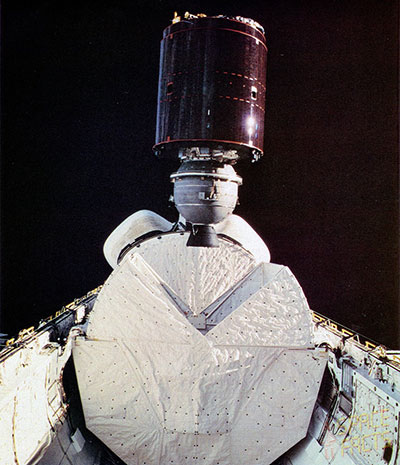 Now on to the covers. The first cover (at top) was cancelled for the deployment of the INSAT-1B Spacecraft on August 31, 1983 during the STS-8 mission. The INSAT-1B Spacecraft was developed by Ford Aerospace and Communications Corporation, located in Palo Alto, California. Because I went to Palo Alto before the Spacecraft was shipped to Cape Canaveral to train their technicians and engineers and because the deployment of INSAT-1B would be the first use of the Uprated PAM-D Spacecraft Separation System that I developed I thought that having covers cancelled there on the day of the INSAT-1B Spacecraft deployment would be an interesting addition to my collection. The PAM system events were nominal and the Spacecraft successfully reached it's 22,300 mile operational orbit. The second cover was cancelled at Huntington Beach, CA, the home of McDonnell Douglas Astronautics Company where the PAM system was developed, for the deployment of the Westar-VI Spacecraft on the STS-41B mission in February, 1984. Due to a failure of the PAM's Solid Rocket Motor nozzle the Spacecraft was left in a lower orbit than planned. The second PAM on this mission also failed to reach the planned transfer orbit due to the same issue and the Palapa-B Spacecraft was also left in a lower than planned orbit. But all was not lost…both Spacecraft were recovered during the STS-51A mission in November 1984, refurbished and reflown on Delta rockets. 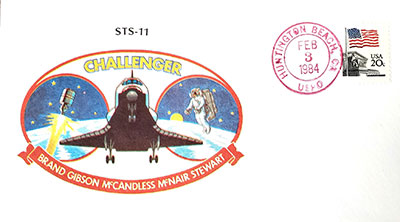 The third cover was cancelled at Huntington Beach, CA for the deployment of the Telstar 3 Spacecraft using the PAM system on September 1, 1984 during the STS-41D mission. The PAM system events were nominal and placed the Spacecraft into a 190 x 22,300 mile elliptical orbit. A solid rocket motor on the Spacecraft was later fired to place the Spacecraft into it's 22,300 mile operational orbit. 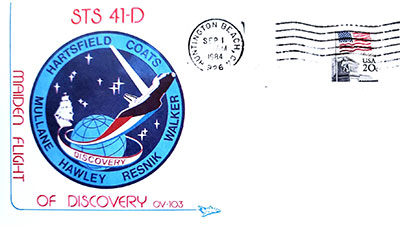 The fourth cover was cancelled at Huntington Beach, CA, for the deployment of the Anik D2 Spacecraft using the PAM system on November 9, 1984 during the STS-51A mission. The PAM system events were nominal and placed the Spacecraft into a 190 x 22,300 mile elliptical orbit. A solid rocket motor on the Spacecraft was later fired to place the Spacecraft into it's 22,300 mile operational orbit. 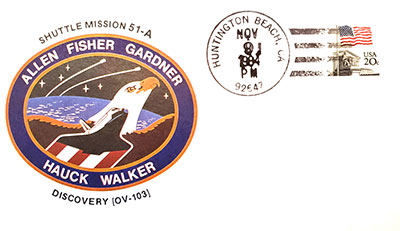 I chose these three covers cancelled at Huntington Beach, CA because they show the three different versions of cancellations used at the post office. I hope that you found my first SCOTW interesting and informative. If you have covers that are cancelled at the locations of the company that built a Spacecraft that was deployed from the Shuttle, the companies that developed Spacecraft deployment systems or on company envelopes from these contractors please post them. |
micropooz
Member Posts: 1854
From: Washington, DC, USA
Registered: Apr 2003
|
 posted 06-01-2025 01:48 PM
posted 06-01-2025 01:48 PM
   
Hey welcome to SCOTW Randy! And with a subject that is also near and dear to my heart - I trained seven crews (41D, 51A, 51D, 51G, 51I, 61B, and 61C) to deploy their PAM payloads as a MDAC employee in Houston, 1984-86. I only tried to collect a cover or two for each deploy and all are KSC, CC, or Houston cancels. Never thought about pursuing covers postmarked in Huntington Beach (where the PAM system was built) or the satellite vendor facilities (Palo Alto for Insat as you showed; Princeton, NJ for 51I/ASC, 61B/Satcom-K2, 61C/Satcom-K1; or El Segundo, CA for the rest). Hopefully there are more out there! And by the way, interesting timing - I am drafting an article on the PAM system for an issue of Quest this Fall. I'm dusting off brain cells that haven't seen the light of day in almost 40 years! I should run the draft by you for a sanity check! |
randyc
Member Posts: 933
From: Denver, CO USA
Registered: May 2003
|
 posted 06-01-2025 03:50 PM
posted 06-01-2025 03:50 PM
   
Thanks for the welcome Dennis! I appreciate that I'm now a member of a small but distinguished group of Astrophilatelists!  I didn't train astronauts in the PAM system as you did. My training experience was focused on installing the Uprated PAM-D Spacecraft Separation System. Because it was tensioned to 7800 lbs. vs 5700 lbs. for the Standard PAM-D Spacecraft Separation System I had to develop a new installation tool and installation procedure, so I trained the engineers and technicians at the Spacecraft contractor (Ford Aerospace for INSAT and Aerospatiale for ARABSAT). I was also at KSC when the Spacecraft were mated to the flight PAMs by the McDonnell Douglas engineers and technicians. Perhaps your experience training crews can be a topic for one of your SCOTW postings. I'm certainly no expert on the Payload Assist Module but would be happy to look over your draft article. Maybe I can 'add value' by finding a misspelled word! |
Bob M
Member Posts: 2045
From: Atlanta-area, GA USA
Registered: Aug 2000
|
 posted 06-02-2025 02:17 PM
posted 06-02-2025 02:17 PM
   
Very impressive, informative and interesting SCOTW debut, Randy. Welcome to the SCOTW Gang of Eight. I have some PAM-related covers to add to your post, with them having some interesting labels and cachets applied. Shown here are PAM-related covers for STS-41D, STS-7 and STS-51A.  The 41D cover has a small cachet for the Hughes SBS-4 PAM deployment and is autographed by Robert J. Wood. Wood was Charlie Walker's back-up on 41D and was later assigned to Shuttle mission 61-M, but it was canceled after 51L. Sadly, Wood died in a car accident in 2009. The STS-51A cover, with a Hughes PAM label applied, is canceled for both satellite retrievals after PAM failures on 41B. STS-51A also deployed ANIK 2 (Telstat-H) and LEASAT 1 (Syncom IV-1) with PAMs - two up, two down.  The two STS-51A covers are canceled on the dates of the retrieval of PALAPA B-2 on EVA-1 and the retrieval of Weststar-V1 on EVA-2. Both were stranded in low earth orbit by PAM failures on STS-41B. But both were later successfully placed in orbit by other PAM boosters. It would be interesting to learn the source of the small added cachets.  Of course, Payload Assist Modules preformed well on many Shuttle flights after and before the twin failures on STS-41B. For example, on STS-7, PAMs boosted both the ANIK C-2 and PALAPA B satellites into geostationary orbits using PAM-D's. These two STS-7 covers have ANIK C and PALAPA B labels from Hughes Aircraft affixed as cachets and canceled for the STS-7 launch. |
Ken Havekotte
Member Posts: 3976
From: Merritt Island, Florida, Brevard
Registered: Mar 2001
|
 posted 06-02-2025 04:21 PM
posted 06-02-2025 04:21 PM
   
Wonderful postings Randy and Dennis about your direct participation with the PAM-satellite deployment programs, mainly with the shuttle and Delta. I recall covering all the PAM flights here at Kennedy and picking up a lot of contractor literature, photos, etc. that helped me to better understand their crucial role in our nation's space efforts. I envy you both very much for having such important PAM responsibilities and leadership roles as top engineers and personnel trainers. Thanks to Bob for postings all the covers that he did. All of them were of my own productions as I spent a lot of time working on them mostly for shuttle flights of the 1980's. The added small rubber stamps at bottom right helped to commemorate various PAM-related satellite deployments from the orbiter's payload bay and retrievals from outside the shuttle. And not to mention that I enjoy decal sticker cachets and had a lot of fun with making sure they would all fit the best they could. A few had to be trimmed a bit or folded back to affix their bottom portions on the reverse side of some envelope covers. |
Bob M
Member Posts: 2045
From: Atlanta-area, GA USA
Registered: Aug 2000
|
 posted 06-04-2025 09:06 AM
posted 06-04-2025 09:06 AM
   
To continue with our SCOTW PAM Week, here are two more PAM-related covers. The two failed PAM-assisted deployments occurred on STS-41B, which otherwise was much better known for two historic space firsts. Bruce McCandless accomplished the first untethered free flight, Extra Vehicular Activity (EVA), in space using a Manned Maneuvering Unit (MMU) and flew separated from anything, including the orbiter, at 17,000 mph as a human satellite. Of more significance, Space Shuttle orbiter Challenger landed back at its launch site, KSC, accomplishing the first manned spacecraft landing at the location of its launch. Before STS-41B, every US and Soviet manned orbital flight returned to earth far from their launch sites. The STS-41B cover above has cancels for the two failed satellite deployments that occurred on February 3 (Westar V1) and 6 (PALAPA B-2), 1984. The cover was later mailed signed by the Vice-President of Space Programs at McDonald Douglas Astronautics, the maker of the PAM-D upper-stage, and the Manager of the Space Propulsion Division at Morton Thiokol, the maker of the PAM-D (Star 48) solid rocket motor (They might not have been thrilled to sign a cover for this unhappy flight for them). We have two PAM experts here and it would be good to learn from them what was the cause of the failures of the two PAMs on STS-41B, where otherwise PAMs preformed well. Also how many PAMs were used in the Shuttle Program? The other cover marks the successful PAM deployment of the AUSSAT 1 satellite on STS-51I in 1985. |
micropooz
Member Posts: 1854
From: Washington, DC, USA
Registered: Apr 2003
|
 posted 06-04-2025 10:10 AM
posted 06-04-2025 10:10 AM
   
The 41B PAM nozzle failures were due to the rocket motor manufacturer (Thiokol) trying a new design for the insulation inside the motor nozzle. I don't remember if the insulation either came loose or eroded away faster than expected. But the net effect was to depressurize the inside of the motor before the propellant was done burning, which resulted in less impulse being generated, hence the payloads went into transfer orbits too low to let them reach geosynchronous orbit. Needless to say, the nozzle design got fixed after 41B.Eighteen PAM-D's and two PAM D-IIs were deployed from Shuttle from 1982 - 1986. In 1990 a STAR 48B rocket motor (same as PAM-D) was used in conjunction with an IUS upper stage to boost Ulysses on its' way to solar orbit. This was called a PAM-S (S for "Special"). |
Bob M
Member Posts: 2045
From: Atlanta-area, GA USA
Registered: Aug 2000
|
 posted 06-04-2025 02:18 PM
posted 06-04-2025 02:18 PM
   
Thanks, Dennis, for your expert explanation of the cause of the PAM failures. I'm slowly becoming an amateur expert on those darn PAMs  . .And for Ken, yes, I got these covers from you and they were well-done, as usual. Your production of covers, and with appropriate cancels, during the Shuttle era are appreciated and admired by this collector and certainly by many others. While Ken had the 41B cover above nicely done with cancels for the two PAM failures - probably the only such covers done - I get credit for having the two PAM managers apply their autographs and positions to the two covers, resulting in probably a unique cover for this unusual event. For those with an interest in autographs and what's sometimes involved in obtaining them: I mailed the cover to McDonald Douglas Aeronautics in Santa Anna, CA and it came back postmarked from St. Louis, MO, and I then mailed the cover to Thiokol in Brigham City, UT and it returned from Baltimore, MD - so the cover got some help and mileage on it (and I probably had two such covers autographed and Ken probably has the other somewhere in his vast collection). |
Jim Behling
Member Posts: 1996
From: Cape Canaveral, FL
Registered: Mar 2010
|
 posted 06-04-2025 04:08 PM
posted 06-04-2025 04:08 PM
   
quote:
Originally posted by micropooz:
Eighteen PAM-D's and two PAM D-IIs were deployed from Shuttle from 1982 - 1986. In 1990 a STAR 48B rocket motor (same as PAM-D) was used in conjunction with an IUS upper stage to boost Ulysses on its' way to solar orbit. This was called a PAM-S (S for "Special").
Thirteen (13) PAM-Ds also flew on Delta. The STAR-48 used on Ulysses was called a PAM because it used PAM avionics. Unlike, the 90 or so other STAR-48s that flew on Delta that used an ordnance based sequencing for post separation events, the STAR-48 that flew on Pluto New Horizons was called a Delta II third stage because it used the same spin table and ordnance. The STAR-48 on Parker Solar Probe used Northrop Grumman avionics and had thrust vector control. |
SpaceAholic
Member Posts: 5470
From: Sierra Vista, Arizona
Registered: Nov 1999
|
 posted 06-04-2025 11:28 PM
posted 06-04-2025 11:28 PM
   
quote:
Originally posted by randyc:
The second PAM on this mission also failed to reach the planned transfer orbit due to the same issue and the Palapa-B Spacecraft was also left in a lower than planned orbit.
Tangential note - following malfunction of the Palapa B PAM (aka Perigee Kick Motor (PKM)), it was jettisoned to expose the Apogee Kick Motor (AKM) - essentially a lower impulse variant of the PKM solid - which was then fired to position the satellite in a nominal orbit for subsequent recovery. The AKM served one additional unplanned purpose during the STS-51A recovery operations - its nozzle, with an EVA installed specialized tool (Stinger) functioned as an improvised grappling fixture for the shuttle's Canadarm to effect the satellite's retrieval. That AKM nozzle was post flight de-integrated upon return and eventually found its way into my collection.  |
micropooz
Member Posts: 1854
From: Washington, DC, USA
Registered: Apr 2003
|
 posted 06-05-2025 06:59 AM
posted 06-05-2025 06:59 AM
   
Now, THAT is the ultimate PAM artifact!!! |
Bob M
Member Posts: 2045
From: Atlanta-area, GA USA
Registered: Aug 2000
|
 posted 06-05-2025 09:34 AM
posted 06-05-2025 09:34 AM
   
Space Cover of the Week's PAM Week has gone well, with a lot of interesting information and covers - and even an artifact. We all should now be well-informed on Payload Assist Modules. As a change of pace, next week will be Prime Recovery Ship Cover Week, which should generate some interest. We will switch from PAM Week to PRS Week. |
micropooz
Member Posts: 1854
From: Washington, DC, USA
Registered: Apr 2003
|
 posted 06-06-2025 06:10 PM
posted 06-06-2025 06:10 PM
   
So let me finish by showing one interesting cover for the STS-51I deploys of Aussat-1 and ASC-1 (pictured).  This is an IASP cover (a Bill York creation, I think) postmarked on the launch day for STS-51I, Aug 27, 1985 at KSC. As the caption on the cover mentions, both Aussat-1 and ASC-1 were deployed on Flight Day 1 (FD1), the day of launch. Where the caption talks about a malfunction in the Aussat-1 sunshield, that is true, but the story is deeper than just that. As I mentioned earlier in this thread, I'm drafting an article on PAM for Quest Magazine, and I owe them first shot on the 51I story. The RMS malfunction that the caption noted did not play into the decision to deploy Aussat-1 on FD1. ASC-1 was deployed on FD1, as originally planned.
If Quest picks up my article, you can see the story there. If they don't pick up the article, I'll add the 51I story to this thread. | |
Contact Us | The Source for Space History & Artifacts
Copyright 1999-2025 collectSPACE. All rights reserved.

Ultimate Bulletin Board 5.47a
|
|

|
 advertisement advertisement

|























